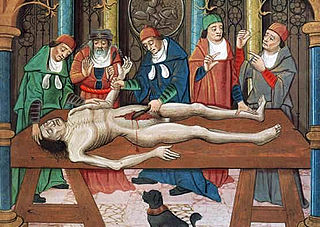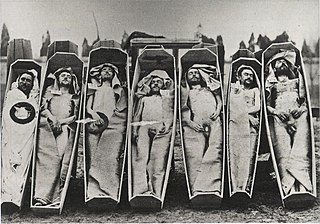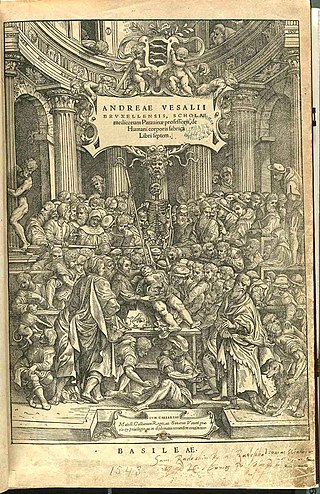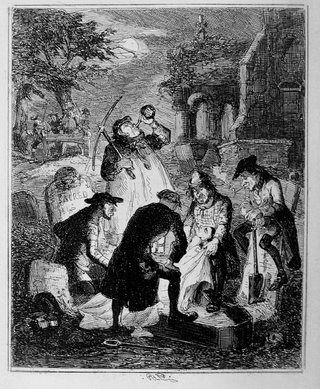
Andries van Wezel, latinised as Andreas Vesalius, was an anatomist and physician who wrote De Humani Corporis Fabrica Libri Septem, what is considered to be one of the most influential books on human anatomy and a major advance over the long-dominant work of Galen. Vesalius is often referred to as the founder of modern human anatomy. He was born in Brussels, which was then part of the Habsburg Netherlands. He was a professor at the University of Padua (1537–1542) and later became Imperial physician at the court of Emperor Charles V.

The history of anatomy extends from the earliest examinations of sacrificial victims to the sophisticated analyses of the body performed by modern anatomists and scientists. Written descriptions of human organs and parts can be traced back thousands of years to ancient Egyptian papyri, where attention to the body was necessitated by their highly elaborate burial practices.

The history of anatomy in the 19th century saw anatomists largely finalise and systematise the descriptive human anatomy of the previous century. The discipline also progressed to establish growing sources of knowledge in histology and developmental biology, not only of humans but also of animals.

Mondino de Luzzi, or de Liuzzi or de Lucci,, also known as Mundinus, was an Italian physician, anatomist and professor of surgery, who lived and worked in Bologna. He is often credited as the restorer of anatomy because he made seminal contributions to the field by reintroducing the practice of public dissection of human cadavers and writing the first modern anatomical text.

Dissection is the dismembering of the body of a deceased animal or plant to study its anatomical structure. Autopsy is used in pathology and forensic medicine to determine the cause of death in humans. Less extensive dissection of plants and smaller animals preserved in a formaldehyde solution is typically carried out or demonstrated in biology and natural science classes in middle school and high school, while extensive dissections of cadavers of adults and children, both fresh and preserved are carried out by medical students in medical schools as a part of the teaching in subjects such as anatomy, pathology and forensic medicine. Consequently, dissection is typically conducted in a morgue or in an anatomy lab.

Body snatching is the illicit removal of corpses from graves, morgues, and other burial sites. Body snatching is distinct from the act of grave robbery as grave robbing does not explicitly involve the removal of the corpse, but rather theft from the burial site itself. The term 'body snatching' most commonly refers to the removal and sale of corpses primarily for the purpose of dissection or anatomy lectures in medical schools. The term was coined primarily in regard to cases in the United Kingdom and United States throughout the 17th, 18th, and 19th centuries. However, there have been cases of body snatching in many countries, with the first recorded case dating back to 1319 in Bologna, Italy.

Grave robbery, tomb robbing, or tomb raiding is the act of uncovering a grave, tomb or crypt to steal commodities. It is usually perpetrated to take and profit from valuable artefacts or personal property. A related act is body snatching, a term denoting the contested or unlawful taking of a body, which can be extended to the unlawful taking of organs alone.

The Body Snatcher is a 1945 American horror film directed by Robert Wise, based on the 1884 short story of the same name by Robert Louis Stevenson. Philip MacDonald adapted the story for the screen, and producer Val Lewton, credited as "Carlos Keith", modified MacDonald's screenplay. The film stars Boris Karloff as John Gray, a cab driver who moonlights as a grave robber, and later murderer, to illegally supply Dr. MacFarlane with cadavers for his classes, and makes mention of Burke, Hare, and Dr. Knox, in reference to the West Port murders of 1828. Alongside Karloff and Daniell, the film's cast includes Russell Wade, Edith Atwater, and Bela Lugosi. It was the last film in which both Karloff and Lugosi appeared.
A tissue bank is an establishment that collects and recovers human cadaver tissue for the purposes of medical research, education and allograft transplantation. A tissue bank may also refer to a location where biomedical tissue is stored under cryogenic conditions and is generally used in a more clinical sense.
The London Burkers were a group of body snatchers operating in London, England, who apparently modeled their activities on the notorious Burke and Hare murders. They came to prominence in 1831 for murdering victims to sell to anatomists, by luring and drugging them at their dwelling in the northern end of Bethnal Green, near St Leonard's, Shoreditch in London. They were also known as the Bethnal Green Gang.

A cadaver or corpse is a dead human body. Cadavers are used by medical students, physicians and other scientists to study anatomy, identify disease sites, determine causes of death, and provide tissue to repair a defect in a living human being. Students in medical school study and dissect cadavers as a part of their education. Others who study cadavers include archaeologists and arts students. In addition, a cadaver may be used in the development and evaluation of surgical instruments.

The Medical Renaissance, from around 1400 to 1700 CE, was a period of progress in European medical knowledge, with renewed interest in the ideas of the ancient Greek, Roman civilizations and Islamic medicine, following the translation into Medieval Latin of many works from these societies. Medical discoveries during the Medical Renaissance are credited with paving the way for modern medicine.
A prosection is the dissection of a cadaver or part of a cadaver by an experienced anatomist in order to demonstrate for students anatomic structure. In a dissection, students learn by doing; in a prosection, students learn by either observing a dissection being performed by an experienced anatomist or examining a specimen that has already been dissected by an experienced anatomist.
An anatomy murder is a murder committed in order to use all or part of the cadaver for medical research or teaching. It is not a medicine murder because the body parts are not believed to have any medicinal use in themselves. The motive for the murder is created by the demand for cadavers for dissection, and the opportunity to learn anatomy and physiology as a result of the dissection. Rumors concerning the prevalence of anatomy murders are associated with the rise in demand for cadavers in research and teaching produced by the Scientific Revolution. During the 19th century, the sensational serial murders associated with Burke and Hare and the London Burkers led to legislation which provided scientists and medical schools with legal ways of obtaining cadavers. Rumors persist that anatomy murders are carried out wherever there is a high demand for cadavers. These rumors, like those concerning organ theft, are hard to substantiate, and may reflect continued, deep-held fears of the use of cadavers as commodities.

Mark Twain Cave — originally McDowell's Cave — is a show cave located near Hannibal, Missouri. It was named for author Mark Twain whose real name was Samuel Langhorne Clemens. Clemens lived in Hannibal from 1839 to 1853, age 4 to 17. It is the oldest operating show cave in the state, giving tours continuously since 1886. Along with nearby Cameron Cave, it became a registered National Natural Landmark in 1972, with a citation reading "Exceptionally good examples of the maze type of cavern development." The cave — as "McDougal's Cave" — plays an important role in the novel The Adventures of Tom Sawyer (1876) by Mark Twain and was renamed in honor of the author in 1880.

Resurrectionists were body snatchers who were commonly employed by anatomists in the United Kingdom during the 18th and 19th centuries to exhume the bodies of the recently dead. Between 1506 and 1752 only a very few cadavers were available each year for anatomical research. The supply was increased when, in an attempt to intensify the deterrent effect of the death penalty, Parliament passed the Murder Act 1752. By allowing judges to substitute the public display of executed criminals with dissection, the new law significantly increased the number of bodies anatomists could legally access. This proved insufficient to meet the needs of the hospitals and teaching centres that opened during the 18th century. Corpses and their component parts became a commodity, but although the practice of disinterment was hated by the general public, bodies were not legally anyone's property. The resurrectionists therefore operated in a legal grey area.

The doctors' riot was an incident that occurred in April 1788 in New York City, where the illegal procurement of corpses from the graves of the recently deceased caused a mass expression of discontent from poorer New Yorkers that was directed primarily at physicians and medical students.
The Pennsylvania Anatomy Act of 1883 is legislation of the State of Pennsylvania to facilitate medical education. This act allowed teachers and students to be able to dissect bodies without have to resort to buying from grave robbers or buying body parts. This act was written to prevent grave robbing, and to even out the availability of corpses.
As anatomy classes in medical education proliferated in the 19th century, so too did the need for bodies to dissect. Grave robbery proliferated, along with associated social discontent, revulsion, and unhappiness. Conflicts arose between medical practitioners and defenders of bodies, graves and graveyards. This resulted in riots. Social legislation was passed in many countries to address the competing concerns.
"An Act to Promote Medical Science and Protect Burial Grounds", informally known as the Bone Bill, was an 1854 bill in New York. Its purpose was to greatly increase the number of cadavers available for legal dissection in medical schools.













